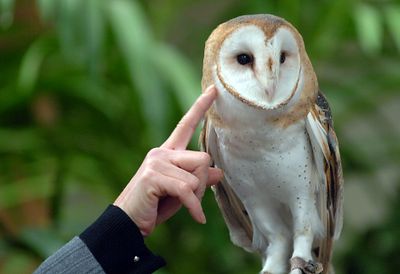Program offers owl insight

Owls will be coming out of the dark to shed some light on their species next weekend for a free program at Lake Coeur d’Alene.
“Because they are most active when we are sleeping, owls are an often forgotten segment of our local birds of prey,” said Carrie Hugo, Idaho Fish and Game Department wildlife biologist.
Handlers will bring live owls to Blackwell Island to help the curious understand the utility of the stealth creature’s large eyes and haunting calls.
“In some Native American cultures, owls are believed to be harbingers of death,” Hugo said. “In Africa, owls are widely regarded as evil. On the other hand, the Greeks regarded the owl as a symbol of wisdom and the bearer of knowledge.”
Modern western culture leans toward the “wise ol’ owl” sentiment, as owls play that role in popular programming such as Bambi and Winnie the Pooh.
But owls may be little more than vermin to a chicken farmer.
Most owls in this region are welcome neighbors, since they prey mostly on mice or voles. A barn owl that hunts the Rathdrum Prairie might eat 3-4 mice a night – more than 12,500 a year, Hugo said.
Smaller owls, such as the northern pygmy owl, also eat insects.
However, larger varieties, such as the great horned owl, are equipped to dine on anything from mice to squirrels, rabbits and even cats and skunks.
Since most owls are largely nocturnal, they have large eyes that enable them to hunt and navigate in the dark. “Owl eyes do not move in their sockets like ours do,” Hugo said. “The owl has to move its entire head towards what it is trying to see.”
This is not a setback, since owls can rotate their heads 270 degrees.
“To locate their dinner, owls use an enhanced sense of hearing to guide them to a mouse running through the tall grass,” Hugo explained. “The facial disks of feathers around their eyes help funnel sound into their ears.”
Once prey is located, their outstanding vision takes the lead in one of the stealthiest attacks from the sky.
“Unlike all other birds, owls have feathers with a special adaptation that functions as a ‘silencer,’ Hugo said. “As air crosses the wing in many birds, the disturbance creates a ‘whooshing’ or whistling sound. Not so in the owl family, where ambushing prey is a must for survival. Their feathers have a comb-like edge that effectively muffles the sound, making their flight in pursuit of prey almost silent.”
Idaho has 13 resident owl species – and a couple of regular winter visitors, such as the snowy owl. The residents have a wide range of nesting behaviors, from shallow scrapes in the ground to tree cavities or nest boxes, or taking over old nests of crows, hawks and other birds.
Owls are good at everything they do, including saving time on domestic matters.
“They don’t build their own nests,” Hugo said.